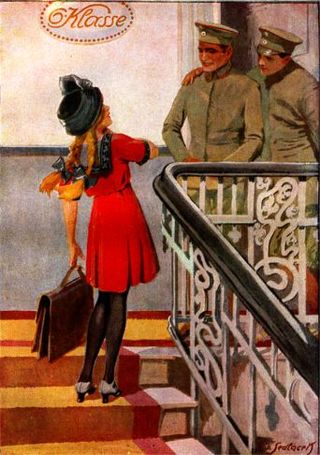
German literature comprises those literary texts written in the German language. This includes literature written in Germany, Austria, the German parts of Switzerland and Belgium, Liechtenstein, Luxembourg, South Tyrol in Italy and to a lesser extent works of the German diaspora. German literature of the modern period is mostly in Standard German, but there are some currents of literature influenced to a greater or lesser degree by dialects.

John Henry Mackay was a Scottish-German egoist anarchist, thinker and writer. Born in Scotland and raised in Germany, Mackay was the author of Die Anarchisten and Der Freiheitsucher.

"Ring a Ring o' Roses", "Ring a Ring o' Rosie", or "Ring Around the Rosie", is a nursery rhyme, folk song and playground singing game. Descriptions first emerge in the mid-19th century, but are reported as dating from decades before, and similar rhymes are known from across Europe, with various lyrics. It has a Roud Folk Song Index number of 7925.

Ricarda Huch was a pioneering German intellectual. Trained as a historian, and the author of many works of European history, she also wrote novels, poems, and a play. Asteroid 879 Ricarda is named in her honour.

Weimar Classicism was a German literary and cultural movement, whose practitioners established a new humanism from the synthesis of ideas from Romanticism, Classicism, and the Age of Enlightenment. It was named after the city of Weimar, Germany, because the leading authors of Weimar Classicism lived there.

Franz Kafka, a German-language writer of novels and short stories who is regarded by critics as one of the most influential authors of the 20th century, was trained as a lawyer and later employed by an insurance company, writing only in his spare time.

Else Ury was a German-Jewish novelist and children's book author. Her best-known character is the blonde doctor's daughter Annemarie Braun, whose life from childhood to old age is told in the ten volumes of the highly successful Nesthäkchen series.

Gabriele Reuter was a German writer.

Steven Lehrer is a physician and writer, known for medical research and for his English translation of Else Ury.

Clementine Helm Beyrich was a widely read author of books for children and young adults who published her works during the period of the German Empire.

Else Ury's Nesthäkchen is a Berlin doctor's daughter, Annemarie Braun, a slim, golden blond, quintessential German girl. The ten-book Nesthäkchen series follows Annemarie from infancy to old age and grandchildren. This third volume of the series, published 1915/1921, tells the story of ten-year-old Annemarie's bout of scarlet fever, her recovery in a North Sea children's sanitorium, and her desperate struggle to return home at the outbreak of World War I.

Nesthäkchen's First School Year is the second book in the Nesthäkchen series, written by Else Ury. Nesthäkchen is a Berlin doctor's daughter, Anne Marie Braun, a slim, golden blond, quintessential German girl. The series follows Annemarie from infancy to old age and grandchildren.

A Nesthäkchen is the youngest child in a family. Else Ury's Nesthäkchen is a Berlin doctor's daughter, Annemarie Braun, a slim, golden blond, quintessential German girl. The ten-book Nesthäkchen series follows Annemarie from infancy to old age and grandchildren. The first volume of the series, originally published by Meidingers Jugendschriften Verlag Berlin 1913, tells the story of Annemarie's early life.

Else Ury's Nesthäkchen is a Berlin doctor's daughter, Annemarie Braun, a slim, golden blond, quintessential German girl. The ten book Nesthäkchen series follows Annemarie from infancy to old age and grandchildren . Volume 5, Nesthäkchens Backfischzeit, describes Annemarie's teenage years.

Else Ury's Nesthäkchen is a Berlin doctor's daughter, Anne Marie Braun, a slim, golden blond, quintessential German girl. The ten-book Nesthäkchen series follows Annemarie from infancy to old age and grandchildren. Volume 4 describes Anne Marie's experiences in World War I from 1914 to 1916.

Nesthäkchen Flies From the Nest is a 1921 German-language novel written by Else Ury. It is the sixth book in Ury's ten-book Nesthäkchen series, which follows protagonist Annemarie from infancy through old age. Nesthäkchen Flies From the Nest covers Annemarie's college days, courtship, and marriage.

Nesthäkchen und ihre Küken is the seventh volume of the ten-book Nesthäkchen series by Else Ury. This volume was published in 1923. Nesthäkchen is Annemarie Braun, a Berlin doctor's daughter, a slim, golden blond, quintessential German girl. The series follows Annemarie from infancy (Nesthäkchen and Her Dolls) to old age and grandchildren (Nesthäkchen with White Hair). Nesthäkchen und ihre Küken describes Anne Marie's early years of motherhood.

Else Ury's Nesthäkchen is a Berlin doctor's daughter, Annemarie Braun, a slim, golden blond, quintessential German girl. The ten book Nesthäkchen series follows Annemarie from infancy to old age and grandchildren. Volume 10 (1925) describes the education, courtship and marriage of Annemarie’s granddaughter, Marietta, and Annemarie’s first great grandchild.

Emilie Auguste Karoline Henriette Friedrich-FriedrichnéeKühne, known by the pen name Emmy von Rhoden, was a German writer. She is best known for her novel Der Trotzkopf (1885), one of the prototypes of the Backfischroman. It is considered an international classic of Children's literature. She is the mother of writer Else Wildhagen who continued the Trotzkopf-series with two sequels. The last official volume was written by the unrelated Dutch writer Suze la Chapelle-Roobol and translated into German. The series was a huge commercial success in Germany and translated into at least 11 different languages. The success was also due to the marketing effort of the publisher Gustav Weise in Stuttgart.
Else Wildhagen was a German writer. She was the daughter of the author of Der Trotzkopf, Emmy von Rhoden, and the writer Hermann Friedrich Friedrich. She was married to the German jurist, Georg Wildhagen, since 1885.


















